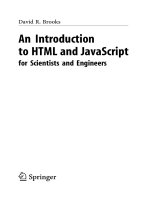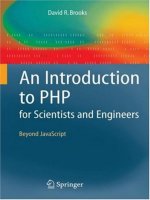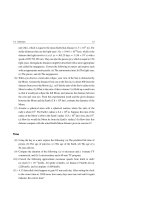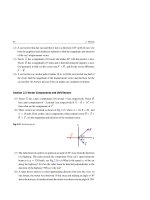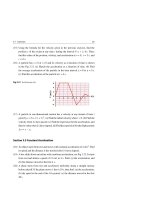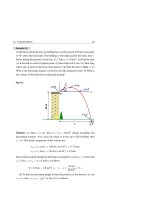springer publishing an introduction to php for scientists and engineers, beyond javascript (2008)
Bạn đang xem bản rút gọn của tài liệu. Xem và tải ngay bản đầy đủ của tài liệu tại đây (2.65 MB, 85 trang )
Introduction to PHP for Scientists and Engineers
David R. Brooks
Introduction to PHP
Beyond JavaScript
123
for Scientists and Engineers
David R. Brooks, PhD
Institute for Earth Sciences Research and Education
2686 Overhill Drive
Norristown, PA 19403
USA
ISBN: 978-1-84800-236-4 e-ISBN: 978-1-84800-237-1
DOI 10.1007/978-1-84800-237-1
British Library Cataloguing in Publication Data
A catalogue record for this book is available from the British Library
Library of Congress Control Number: 2008926361
© Springer-Verlag London Limited 2008
Apart from any fair dealing for the purposes of research or private study, or criticism or review, as
permitted under the Copyright, Designs and Patents Act 1988, this publication may only be
reproduced, stored or transmitted, in any form or by any means, with the prior permission in writing of
the publishers, or in the case of reprographic reproduction in accordance with the terms of licenses
issued by the Copyright Licensing Agency. Enquiries concerning reproduction outside those terms
should be sent to the publishers.
The use of registered names, trademarks, etc., in this publication does not imply, even in the absence
of a specific statement, that such names are exempt from the relevant laws and regulations and
therefore free for general use.
The publisher makes no representation, express or implied, with regard to the accuracy of the information
contained in this book and cannot accept any legal responsibility or liability for any errors or omissions that
may be made.
Printed on acid-free paper
9 8 7 6 5 4 3 2 1
Springer Science+Business Media
springer.com
Preface
The best way to become acquainted with a subject is to write a book about
it.—Benjamin Disraeli
i. Background
The purpose of this book is provide an introduction to using a server-side
programming language to solve some kinds of computing problems that
cannot be solved with a client-side language such as JavaScript. The
language is PHP (originally created in 1994 by Danish/Icelandic
programmer Rasmus Lerdorf as “Personal Home Page Tools” for dealing
with his own web site). The PHP language does not have a formal
specification, as C does, for example. It is developed and maintained by a
User Group of volunteers and is, essentially, defined by the most recently
available free download. Although this might seem to be a shaky
foundation on which to make a commitment to learning a programming
language, PHP has a very large world-wide base of users and applications,
which ensures its role into the foreseeable future.
This book should not be considered as a PHP reference source
and it does not deal exhaustively even with those elements of the PHP
language used in the book. (This should be considered a blessing by the
casual programmer.) If you need more information, there is a huge
amount of information online about PHP. Hopefully, this book will help
you filter this information to focus on solving typical science and
engineering problems. An excellent online source for information about
PHP is maintained by the PHP
Documentation Group.
1
This book is also definitely not intended as an introduction to
programming. It is addressed not to professional programmers, actual or
potential, but to a technical audience with occasional needs to solve
computational problems. It assumes a working knowledge of
programming concepts and HTML/JavaScript in particular, such as that
provided by my book, An Introduction to HTML and JavaScript for
Scientists and Engineers (Springer, 2007, ISBN-13: 978-1-84628-656-8,
1
As with all URL references in this book, this URL was available at the time the
book was written, but there can be no guarantee that it will exist in the future.
vi Preface
e-ISBN-13: 978-1-84628-657-5). Occasionally, this book uses examples
drawn from the HTML/JavaScript book, but they are presented as stand-
alone examples, so you do not need to own the HTML/JavaScript book to
use this one.
Although PHP syntax is not that different from JavaScript, the file
access syntax will be new to JavaScript programmers who have not
previously programmed in a language such as C. C programmers will find
there are some similarities between the file access syntax of PHP and C.
However, the similarities are sometimes superficial and require that PHP
be learned on its own terms, despite the temptation to conclude, “Oh, this
works just like C (or JavaScript).”
As is often the case when I learn something new, I had a very
specific goal when I started to learn about PHP: I needed to be able to
create and access data files stored on a remote server. This is a capability
that scientists and engineers always need, but which JavaScript simply
cannot provide.
As with other texts I have written over the years, I followed the
advice given in the quote at the beginning of this Preface. I wrote the
book basically first for myself, and as a result this book will guide you
through essentially the same steps I followed. As I began writing it, I had
just finished publishing the HTML/JavaScript book mentioned above, so
this book starts precisely where the previous one ended—with a
knowledge of JavaScript sufficient for writing the online applications I
needed, within the limitations of that client-side language.
Chapter 1 deals with the HTML/PHP interface that allows you to
pass information from your local computer to a “remote” server,
regardless of whether that server is really remote or exists on your own
desktop. Chapter 2 deals with the basic elements of the PHP language,
from the perspective of someone who is already familiar with
programming concepts and JavaScript. If you have no idea what a “for
loop” is, you will not be happy with this book!
Chapter 3 deals with arrays, which are a major topic because
PHP’s implementation of arrays is much richer and more complex than
JavaScript’s. Chapter 4 presents a summary of some elements of the PHP
language used in the book. It is a very small subset of the language, but
one that I have found meets my own needs. As you begin to apply this
language to your own applications, you will no doubt want to make your
own additions to my compilation of essentials. Chapter 5 provides a brief
introduction to using PHP from a text-based command line interface. This
bypasses the need to run PHP on a server and offers some basic facilities
for providing user input to a PHP application from the keyboard.
Preface vii
There are many code examples in this book, most of them very
short. They are “PHP applications” only in the most primitive sense. Their
purpose is to illuminate a specific approach to a particular problem, such
as reading a data file or producing properly formatted output. For anyone
who, like me, does not make his or her living by programming and does
not use a programming language every day, it is very easy to forget the
details of how to achieve even simple tasks. I return to my own code
examples again and again whenever I need to solve a new computing
problem. So, I hope this book and its examples will save you as much
time as they do me!
PHP is often used in conjunction with formal databases. However,
that topic is not discussed at all in this book. Coming from a C
background, I am used to more ad hoc and decidedly more primitive
methods of creating and accessing my own data files. The specialized and
constantly changing applications I need for my own work would only
rarely benefit from a formal database structure.
Another omission that some programmers might find egregious is
the lack of any mention of user-defined objects. Again, this is a decision
based on my own needs. The additional capabilities that might be
provided by creating objects are far outweighed by the practice and
programming overhead required to use them correctly and efficiently. I
believe this is equally true for this book’s intended audience, as well.
A significant benefit of PHP relative to JavaScript is that, from a
user’s perspective, it appears to be a much more stable language. The
language is supported by its own User Group, although it is not possible
to predict the future of this support. Rather than being embedded in a
browser, as JavaScript is, a PHP programming environment must be
downloaded (at no cost) from essentially a single source, so it does not
suffer from the many browser-dependent inconsistencies found in
HTML/JavaScript.
Finally, a brief comment on the specialized nature of the main
example addressed in the first two chapters: I have used it both because it
was of interest to me when I first started to write this book and because I
believe it represents a generic class of scientific and engineering
computing problems. Because there are a lot of calculations, it provides
many examples of how to use PHP’s math functions; these, of course, are
critical in science and engineering applications.
ii. Some typographic conventions used in this book
The code found in documents in this book is always copied directly from
the editor used to create them (Visicomm Media’s AceHTML freeware
viii Preface
editor), as this is the best way to minimize errors and ensure that the code
in the book actually works as intended. This editor displays some
language elements in bold and/or italicized font and color-codes them,
too. Of course, the color-coding is lost in this book, but the boldface and
italicized fonts remain. When code examples in the text are not copied
directly from AceHTML code, I have usually not bothered to reproduce
that editor’s font styles. In any case, those styles, including their presence
or absence in the numerous code examples, have no significance relative
to the PHP language.
Because of the format of this book, it was sometimes necessary to
break lines of code in places where that wouldn’t normally be necessary
or desirable. I have tried to insert breaks in places where they won’t create
mischief with the code, but there may remain some cases where line
breaks reproduced exactly as they appear in the text may produce a syntax
error and prevent a script from executing.
The book contains a glossary with definitions of key terms, and
the first appearance of each term appearing in the glossary is printed in
bold font.
iii. Acknowledgments
I am yet again indebted to my wife Susan for her support and patient
editing of this manuscript, especially considering how closely this chore
followed my previous book on HTML and JavaScript. In the fall of 2007,
I included PHP along with HTML and JavaScript in an introductory
programming course I taught to graduate students in Drexel University’s
School of Biomedical Engineering, Science and Health Systems. Of
course, it is always instructive to teach from a manuscript before
submitting it, and I thank those students for their feedback!
Finally, I acknowledge relying on descriptions of PHP constructs
and functions found online, in particular (but not exclusively) from the
online PHP manual written and maintained by the PHP Documentation
Group, found at us2.php.net/manual/en/. Especially when a succinct
formal definition is available for a function or construct, from a definitive
source, it is often difficult and pointless to try to be “original” about how
Code and references to code elements in the text, such as function
names, are always displayed in
Courier font. In some code examples,
user-supplied text is shown as {Times Roman text enclosed in curly
brackets}. In some examples, including function parameter lists, variable
names are given italicized “generic” names such as
$fileName which the
user can replace with some other application-specific name as needed.
Preface ix
such a description should be worded. However, I have tried to reword
descriptions in a way that is consistent with the coverage provided in this
book and with the needs of its intended audience, as I perceive it.
David R. Brooks
Institute for Earth Science Research and Education
January, 2008
Contents
1 Creating a Server-Side Environment for PHP 1
1.1 Getting Started 1
1.2 More Examples 18
1.2.1 Solving the Quadratic Equation 18
1.2.2 Preventing Multiple Submissions from a Form 20
2 Working with PHP 23
2.1 General Structure of PHP Scripts 23
2.2 Calculations with PHP 24
2.3 More about PHP File Input/Output 40
2.4 Another Example 43
3 PHP Arrays 49
3.1 Array Definition 49
3.2 Array Sorting 54
3.3 Stacks, Queues, and Line Crashers 56
3.4 More Examples 59
3.4.1 The Quadratic Formula Revisited 59
3.4.2 Reading
checkbox Values 62
3.4.3 Building a Histogram Array 66
3.4.4 Shuffle a Card Deck 68
3.4.5 Manage a Data File 69
4 Summary of Selected PHP Language Elements 75
4.1 Data Types and Operators 75
4.2.1 Data Types 75
4.2.1 Operators 76
4.2 Conditional Execution 77
4.2.1 if then… else… Conditional Execution 77
4.2.2 Case-Controlled Conditional Execution 78
4.3 Loops 79
4.3.1 Count-Controlled Loops 80
4.3.2 Condition-Controlled Loops 82
Contentsxii
4.4 Functions and Constructs 83
4.4.1 File Handling and I/O Functions 84
4.4.2 Math Constants and Functions 96
4.4.3 Array Functions and Constructs 99
4.4.4 Miscellaneous Functions and Constructs 102
5 Using PHP from a Command Line 107
5.1 The Command Line Environment 107
5.2 Is a Command Line Interface Useful? 112
Appendices 115
A.1 List of HTML and PHP Document Examples 115
A.2 ASCII Characters for Windows PCs 117
Exercises 121
Glossary 133
Index 137
1
Chapter
1
A.A. Bavry, D.L. Bhatt (eds.), Acute Coronary Syndromes in Clinical Practice
DOI 10.1007/978-1-84800-358-3_1, © Springer-Verlag London Limited 2009
Definition, epidemiology, and prognosis
Cardiovascular disease is an all-encompassing term that includes diseases
of the heart and coronary arteries, as well as diseases in other vascular beds.
It is a major cause of death and disability in the United States, Europe, and
worldwide (see Figure 1.1) [1]. Cardiovascular disease that is present in
vascular beds outside of the coronary arteries is broadly termed peripheral
arterial disease, and patients frequently have disease in such overlapping
locations (see Figure 1.2) [2]. Examples include carotid and cerebro vascular
disease, which are responsible for stroke and transient ischemic attack.
Aortoiliac and femoral artery disease are responsible for limb ischemia
and claudication. Cardiovascular disease can also manifest itself in stable
or unstable forms. Stable coronary artery disease is characterized by stable
angina or silent ischemia detected by stress testing, while unstable coro-
nary artery disease (categorized, more generally, as coronary heart disease)
includes myocardial infarction and unstable angina. An increasingly used
and preferred term for an unstable event is acute coronary syndrome (ACS).
ACS encompasses the spectrum from unstable angina to non-ST-elevation
myocardial infarction and, finally, ST-elevation myocardial infarction. This
Reproduced with permission from the AHA [1].
2 Acute Coronary Syndromes in Clinical Practice
CAD, coronary artery disease; CVD, cerebrovascular disease; PAD,
peripheral arterial disease. Reproduced with permission from Bhatt et al. [2].
chapter will review the epidemiology and prognosis of cardiovascular dis-
ease in general, with a special focus on ACS.
In the United States, cardiovascular disease will affect nearly 80 million
individuals at some point in their lives. Approximately one-half of these
individuals are 65 years of age or older. In fact, the lifetime risk of cardio-
vascular disease is more than 70–80% (see Figure 1.3) [1]. Globally, approxi-
mately 10–15 million individuals die each year from cardiovascular disease,
accounting for approximately one-third of all deaths [3,4]. The World Heath
Organization (WHO) has projected that the number of deaths attributable
to cardiovascular disease will continue to increase to the year 2030, while
deaths from communicable causes will continue to decline [5].
There are nearly 8 million Americans who have had a myocardial infarction,
with an incidence of approximately 1.5 million ACS per year and nearly
200,000 silent myocardial infarctions per year [1]. Of the ACS, two-thirds
are due to unstable angina or non-ST-elevation myocardial infarction, while
one-third is due to ST-elevation myocardial infarction. The incidence of
ACS, similar to cardiovascular disease in general, increases with advanced
Definition, Epidemiology, and Prognosis 3
age, so that the mean age of first myocardial infarction is 66 years for men
and 70 years for women. Globally, the WHO reported that deaths from
cardiovascular diseases are highest for Finnish men and women from the
United Kingdom [5].
ACS portends a poor prognosis. It is estimated that myocardial infarction
results in 15 years of life lost to the individual, and translates into a 5-year
mortality of 50% in patients greater than 70 years of age [1]. Data from a
contemporary randomized clinical trial of patients admitted with a non-ST-
elevation ACS found 30-day mortality to be 3% and death or myocardial
infarction to be 14% [6]. Registry data also revealed the 30-day mortality for
non-ST-elevation myocardial infarction to be 5.1%, which was similar to or
slightly less than the mortality for ST-elevation myocardial infarction (5.1%),
or ST-elevation myocardial infarction with reciprocal ST-depression (6.6%)
[7]. In a nonselected population of patients with ST-elevation myocardial
infarction undergoing lytic therapy, 30-day mortality may be as high as 10%
[8]. Although early outcomes are similar across the ACS spectrum, patients
Figure 1.3 Prevalence of cardiovascular disease
stratified by age and gender
83.0
71.3
39.1
14.8
Data include unstable coronary syndromes (myocardial infarction and unstable angina),
heart failure, stroke and hypertension. Reproduced with permission from the AHA [1].
4 Acute Coronary Syndromes in Clinical Practice
with non-ST-elevation myocardial infarction have a higher late mortality
(8.9% at 6 months), compared with ST-elevation myocardial infarction (6.8%
at 6 months) [7]. Not surprisingly, cardiovascular disease is responsible for
the most deaths in the United States at a rate of approximately one death
every minute (see Figure 1.4) [1].
Although the burden of cardiovascular disease is tremendous, mortality
from myocardial infarction has been declining for the last several decades
after peaking in the early 1970s [9]. In the United States, the death rate from
coronary heart disease in men declined from 540 deaths per 100,000 popula-
tion to 267 deaths per 100,000 population during the period 1980–2000. In
women, the death rate declined from 263 deaths per 100,000 population to
134 deaths per 100,000 population over the same time period [10]. It is esti-
mated that approximately half of this reduction is attributable to improved
cardiovascular treatments. Examples in acute myocardial infarction include
the use of cardiopulmonary resuscitation, aspirin, beta-blockers, angio-
tensin-converting enzyme (ACE) inhibitors, thrombolysis, and primary
angioplasty. The use of angioplasty has increased dramatically, although the
utilization of this therapy is still far from optimal among eligible individuals
[11]. The other half of the reduction in mortality is attributable to cardiovas-
CVD, cardiovascular disease. Reproduced with permission from the AHA [1].
Definition, Epidemiology, and Prognosis 5
cular risk factor modification. From 1980 to 2000, the prevalence of smoking
and physical inactivity was reduced by 32% and 8%, respectively. Systolic
blood pressure was reduced by an absolute of 4 mmHg and total cholesterol
declined by an absolute of 6 mmol/L. The change in risk factors may have
also changed the landscape of ACS since there are now proportionately
more non-ST ACS relative to ST-elevation events [12]. Unfortunately, part
of this benefit has been offset by increases in diabetes and body mass
index. Moreover, the population-wide decline in modifiable risk factors is
likely attenuated due to the global underutilization of anti-hypertensive
and statin medications [2]. A reduction in coronary mortality has also been
documented in other developed countries such as England and Wales [13],
Finland [14], and the Netherlands [15]. While this is reassuring, the reality is
that more people are living longer with cardiovascular disease after having
suffered an acute event [16].
The GRACE (Global Registry of Acute Coronary Events) registry tracks
detailed information including cardiovascular outcomes across the spec-
trum of ACS [17]. From 1999 to 2006 the use of guideline-recommended
medications increased among non-ST-ele va tion myocardial infarction (see
Figure 1.5) and ST-elevation myocardial infarction (see Figure 1.6). The
proportion of patients who did not receive any form of revascularization
therapy for non-ST-elevation ACS decreased from 69% to 58% (p<0.001) due
to a significant increase in the use of percutaneous coronary intervention
(from 17% to 35%; p<0.001). In ST-elevation myocardial infarction, the use
of mechanical reperfusion increased from 32% to 64%, while pharmaco-
logical reperfusion decreased from 50% to 28%; therefore, the propor tion of
patients that did not receive any reperfusion therapy remained con stant at
approximately one-third. Over this follow-up period, early and late death,
early myocardial infarction and late stroke were reduced among non-ST-
elevation myo cardial infarction patients, while, in-hospital death, cardio-
genic shock, myocardial infarction and late stroke were reduced among
ST-elevation myocardial infarction patients.
In summary, cardiovascular disease, especially ACS, represents one of the
most significant public health priorities across the globe. In the last sev-
eral decades, improve ments have been made in reducing the prevalence of
smoking and hyper tension, although unfortunately obesity and diabetes
have increased during this time. As a result of the change in risk factors,
the proportion of ST-elevation myocardial infarction has declined relative
6 Acute Coronary Syndromes in Clinical Practice
ACE-I, angiotensin-converting enzyme inhibitor; ARB, angiotensin II receptor blocker; GP,
glycoprotein; LMWH, low-molecular-weight heparin; PCI, percutaneous coronary inter-
vention; UFH, unfractionated heparin. Reproduced with permission from Fox et al. [17].
Definition, Epidemiology, and Prognosis 7
to non-ST- elevation ACS. While this is good, the long-term prognosis of
non-ST-elevation ACS remains poor. The last several decades have also
seen improvements in reperfusion, revascularization, and adjuvant medical
therapies, which have translated into decreased case-fatality for acute myo-
cardial infarction. Thus, while we can applaud the significant achievements
that have taken place, there is much room for improvement in the care of
ACS patients.
CABG, coronary artery bypass graft; PCI, percutaneous coronary intervention.
Reproduced with permission from Fox et al. [17].
8 Acute Coronary Syndromes in Clinical Practice
ACE-I, angiotensin-converting enzyme inhibitor; ARB, angiotensin II receptor blocker; GP,
glycoprotein; LMWH, low-molecular-weight heparin; PCI, percutaneous coronary inter-
vention; UFH, unfractionated heparin. Reproduced with permission from Fox et al. [17].
Definition, Epidemiology, and Prognosis 9
CABG, coronary artery bypass graft; PCI, percutaneous coronary intervention.
Reproduced with permission from Fox et al. [17].
10 Acute Coronary Syndromes in Clinical Practice
References
1. American Heart Association. Heart disease and stroke statistics – 2008 update at-a-glance.
Available at: www.americanheart.org/downloadable/heart/1200082005246HS_Stats%202008.final.pdf.
Last accessed January 2008.
2. Bhatt DL, Steg PG, Ohman EM, et al. International prevalence, recognition, and treatment
of cardiovascular risk factors in outpatients with atherothrombosis. JAMA 2006; 295:180–189.
3. American Heart Association. International cardiovascular disease statistics: statisti-
cal fact sheet – populations. 2007 update. Available at: www.americanheart.org/downloadable/
heart/1177593979236FS06INTL07.pdf. Last accessed December 2007.
4. Murray CJ, Lopez AD. Mortality by cause for eight regions of the world: global burden of
disease study. Lancet 1997; 349:1269–1276.
5. Mathers CD, Loncar D. Projections of global mortality and burden of disease from 2002 to
2030. PLoS Med 2006; 3:e442.
6. The SYNERGY Trial Investigators. Enoxaparin vs unfractionated heparin in high-risk
patients with non-ST-segment elevation acute coronary syndromes managed with an intended
early invasive strategy. Primary results of the SYNERGY randomized trial. JAMA 2004; 292:45–
54.
7. Savonitto S, Ardissino D, Granger CB, et al. Prognostic value of the admission electrocardio-
gram in acute coronary syndromes. JAMA 1999; 281:707–713.
8. White HD. Thrombin-specific anticoagulation with bivalirudin versus heparin in patients
receiving fibrin o lytic therapy for acute myocardial infarction: the HERO-2 randomized trial.
Lancet 2001; 358:1855–1863.
9. Fuster V. Epidemic of cardiovascular disease and stroke: the three main challenges. Presented
at the 71st Scientific Sessions of the American Heart Association. Circulation 1999; 99:1132–1137.
10. Ford ES, Ajani UA, Croft JB, et al. Explaining the decrease in U.S. deaths from coronary dis-
ease, 1980–200. N Engl J Med 2007; 356:2388–2398.
11. Bhatt DL, Roe MT, Peterson ED, et al. Utilization of early invasive management strategies for
high-risk patients with non-ST-segment elevation acute coronary syndromes. Results from the
CRUSADE quality improvement initiative. JAMA 2004; 292:2096–2104.
12. Rogers WJ, Canto JG, Lambrew CT, et al. Temporal trends in the treatment of over 1.5 million
patients with myocardial infarction in the U.S. from 1990 through 1999: the National Registry of
Myocardial Infarction 1, 2 and 3. J Am Coll Cardiol 2000; 36:2056–2063.
13. Unal B, Critchley A, Capewell S. Explaining the decline in coronary heart disease mortality
in England and Wales between 1981 and 2000. Circulation 2004; 109:1101–1107.
14. Laatikainen T, Critchley J, Vartiainen E, et al. Explaining the decline in coronary heart disease
mortality in Finland between 1982 and 1997. Am J Epidemiol 2005; 162:764–773.
15. Bots ML, Grobbee DE. Decline of coronary heart disease mortality in the Netherlands from
1978 to 1985: contribution of medical care and changes over time in presence of major cardiovas-
cular risk factors. J Cardiovasc Risk 1996; 3:271–276.
16. Lenfant C. Heart research: celebration and renewal.
Circulation 1997; 96:3822–3823.
17. Fox KAA, Steg PG, Eagle KA, et al.; for the GRACE Investigators. Decline in rates of death
and heart failure in acute coronary syndromes, 1999–2006. JAMA 2007; 297:1892–1900.
A.A. Bavry, D.L. Bhatt (eds.), Acute Coronary Syndromes in Clinical Practice
DOI 10.1007/978-1-84800-358-3_2, © Springer-Verlag London Limited 2009
Chapter 2
Pathophysiology
This chapter reviews the key elements in the pathophysiology and natural
history of atherosclerosis. The interaction between the coagulation cascade
and platelet physiology will also be discussed. Our understanding of the
complex pathophysiology of atherosclerosis, the coagulation cascade, and
platelet physiology is important in order to optimize pharmaceutical and
device therapy.
Atherosclerosis
The development of atherosclerosis is influenced by an individual’s risk fac-
tors: hypertension, hyperlipidemia, diabetes, and smoking. Atherosclerosis
progresses over many decades until it is clinically detected [1]. Intimal thick-
ening is present early in life; however, this is not felt to be pathologic. In the
second to third decade of life, monocytes infiltrate the subintima. Once in
the subintima, monocytes become macrophages, which become foam cells
upon the ingestion of cholesterol. This is called a fatty streak or fatty dot and
occurs early in the atherosclerotic disease process, although it progresses
to an advanced plaque as a necrotic core develops. Expansion of this lipid
content into a necrotic core occurs along with degradation of the extracellu-
lar matrix by matrix metalloproteinases and other inflammatory cytokines.
Hemorrhage from the vasa vasorum may also contribute to the enlargement
of the necrotic core. This process is more likely to occur at arterial branch
points, which are areas of low shear stress. At this point, a vulnerable plaque
may be present, characterized by a large necrotic lipid core underlying a thin
fibrous cap. This is also referred to as a thin cap fibroatheroma and it is prone
to rupture at its shoulder. The thin fibrous cap is composed of macrophages,
lymphocytes, type I collagen, and relatively few smooth muscle cells [2].
Plaque rupture
Plaque rupture is responsible for most causes of sudden death and
acute coronary syndromes [3]. Microscopically, plaques that rupture have
decreased smooth muscle cells and increased macrophages and inflamma-
tory cells. Macroscopically, vulnerable plaques are usually characterized by
expansion of the external elastic media, referred to as positive remodeling,
11
12 Acute Coronary Syndromes in Clinical Practice
which preserves the luminal area. This is in contrast to patients with sta-
ble coronary artery disease who usually display negative remodeling or
luminal narrowing. A rupture that leads to coronary occlusion is termed
a ST-elevation myocardial infarction, while partial occlusion is a non-ST-
elevation acute coronary syndrome (see Figure 2.1) [4]. Plaque rupture is
more common in older individuals.
Recently, it has been discovered that vulnerable plaques can undergo
frequent asymptomatic rupture with healing. Healing is characterized by
Stenotic lesions tend to be associated with thick brous caps and produce stable
angina, while vulnerable plaques have a large lipid cores with thin caps and produce
unstable coronary events. CABG, coronary artery bypass grafting; PTCA, percutaneous
transluminal coronary angioplasty, Reprinted with permission from Libby & Theroux [4].
Pathophysiology 13
progressive thickening of the fibrous cap. While it is possible that each rup-
ture can be subclinical, over time this process may result in luminal narrow-
ing and cause stable angina [5]. An important finding is that most unstable
coronary events originate from nonflow-limiting lesions (e.g., less than 70%
stenosis) [6]. The implication is that revascularization of a severe coronary
stenosis is usually done with the intent of symptom relief, rather than
reduction in myocardial infarction or death. The next most common cause
of unstable coronary events is plaque erosion, characterized by increased
smooth muscle cells and decreased macrophages. Plaque erosion is fre-
quently seen in younger individuals. The least common cause of an unstable
coronary event is a calcified nodule (see Figure 2.2) [4].
The most common cause of an unstable coronary event is rupture into a vulnerable
plaque, although other mechanisms are possible. Reprinted with permission from Libby
& Theroux [4].
14 Acute Coronary Syndromes in Clinical Practice
The coagulation cascade
The coagulation cascade is accelerated on the surface of platelets. This proc-
ess can be initiated from multiple points; however, binding of the platelet
glycoprotein VI receptor to subendothelial collagen is one of the important
steps after plaque rupture. This results in platelet adhesion to the suben-
dothelium followed by platelet activation. Fibrinogen mediates the aggrega-
tion of activated platelets through the cross-linking of the glycoprotein IIb/
IIIa receptor. This is called the final common pathway of platelet aggrega-
tion. Glycoprotein IIb/IIIa inhibitors act by preventing the binding of fibrin-
ogen to this receptor. Aspirin blocks cyclooxygenase, which prevents the
conversion of arachidonic acid to prostaglandin G
2
and thromboxane A
2
.
These two agents cause potent platelet aggregation and vasoconstriction.
Thienopyridines (e.g., clopidogrel) prevent platelet activation and aggrega-
tion by blocking the platelet adenosine diphosphate receptor. Aggregated
platelets combine with fibrin to form thrombus. A platelet-rich thrombus
forms at areas of high shear stress and is called a white thrombus, while a
fibrin-rich thrombus is called a red thrombus. A red thrombus forms at areas
of relative hemostasis, and can therefore trap red blood cells within the
fibrin mesh. Fibrin is the final product of the coagulation cascade, which is
the meeting point of the extrinsic and intrinsic pathways. Exposure of tissue
factor after plaque rupture initiates the process that converts prothrombin
to thrombin, which in turn converts fibrinogen to fibrin. Tissue factor is the
main stimulus for thrombin generation after plaque disruption.
References
1. Libby P. Molecular bases of the acute coronary syndromes. Circulation 1995; 91:2844–2850.
2. Kolodgie FD, Burke AP, Farb A, et al. The thin-cap fibroatheroma: a type of vulnerable plaque:
the major precursor lesion to acute coronary syndromes. Curr Opin Cardiol 2001; 16:285–292.
3. Virmani R, Kolodgie FD, Burke AP, et al. Lessons from sudden coronary death: a comprehen-
sive morphological classification scheme for atherosclerotic lesions. Arterioscler Thromb Vasc Biol
2000; 20:1262–1275.
4. Libby P, Theroux P. Pathophysiology of Coronary Artery Disease. Circulation 2005; 111:3481–
3488.
5. Burke AP, Kolodgie FD, Farb A, et al. Healed plaque ruptures and sudden coronary death:
evidence that subclinical rupture has a role in plaque progression. Circulation 2001; 103:934–940.
6. Ambrose JA, Tannenbaum MA, Alexopoulos D, et al. Angiographic progression of coronary
artery disease and the development of myocardial infarction. J Am Coll Cardiol 1988; 12:56–62.

